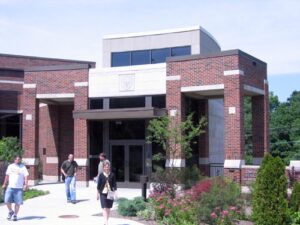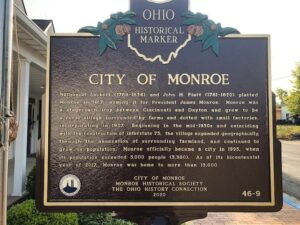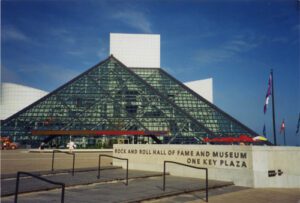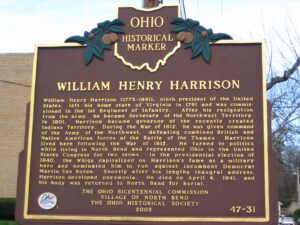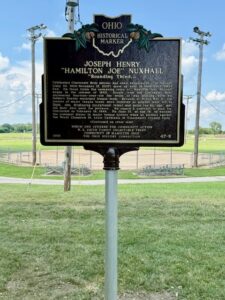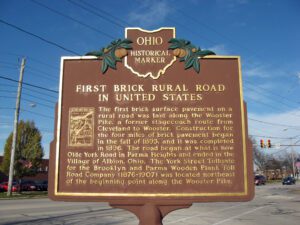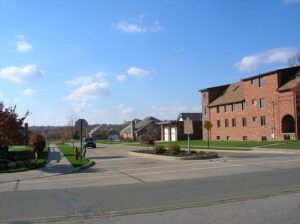, OH
Dr. Jacob Rader Marcus (1896-1995), pioneering historian of the American Jew, founded the American Jewish Archives (AJA) in Cincinnati in 1947. In the aftermath of World War II and the brutal destruction of European Jewry, Marcus anticipated the need to establish a central repository dedicated to preserving the history of North American Jewry. The AJA, which began with a few boxes of documents, has become one of the world’s largest catalogued collections of primary source material on the history of American Jewry. An international community of scholars, researchers, and students utilizes the AJA’s vast archival holdings.
, OH
Nathanial Sackett (1768-1854) and John H. Piatt (1781-1820) platted Monroe in 1817, naming it for President James Monroe. Monroe was a stagecoach stop between Cincinnati and Dayton and grew to be a rural village surrounded by farms and dotted with small factories, incorporating in 1907. Beginning in the mid-1950s and coinciding with the construction of Interstate 75, the village expanded geographically, through the annexation of surrounding farmland, and continued to grow in population. Monroe officially became a city in 1995, when its population exceeded 5,000 people (5,380). As of its bicentennial year of 2017, Monroe was home to more than 13,000.
, OH
When radio station WJW disc jockey Alan Freed (1921-1965) used the term “rock and roll” to describe the uptempo black rhythm and blues records he played beginning in 1951, he named a new genre of popular music that appealed to audiences on both sides of 1950s American racial boundaries–and dominated American culture for the rest of the 20th century. The popularity of Freed’s nightly “Moon Dog House Rock and Roll Party” radio show encouraged him to organize the Moondog Coronation Ball–the first rock concert. Held at the Cleveland Arena on March 21, 1952, the oversold show was beset by a riot during the first set. Freed, a charter inductee into the Rock and Roll Hall of Fame, moved to WINS in New York City in 1954 and continued to promote rock music through radio, television, movies, and live performances.
, OH
William Henry Harrison (1773-1841), ninth president of the United States, left his home state of Virginia in 1791 and was commissioned in the 1st Regiment of Infantry. After his resignation from the army, he became Secretary of the Northwest Territory. In 1801, Harrison became governor of the recently created Indiana Territory. During the War of 1812, he was given command of the Army of the Northwest, defeating combined British and Native American forces at the Battle of the Thames. Harrison lived here following the War of 1812. He turned to politics while living in North Bend and represented Ohio in the United States Congress for two terms. In the presidential election of 1840, the Whigs capitalized on Harrison’s fame as a military hero and nominated him to run against incumbent Democrat Martin Van Buren. Shortly after his lengthy inaugural address, Harrison developed pneumonia. He died on April 4, 1841, and his body was returned to North Bend for burial.
, OH
Celebrated Cincinnati Reds pitcher and radio broadcaster, Joe Nuxhall (July 30, 1928 – November 15, 2007) grew up here in Hamilton’s North End. On these fields the endearing story of “Hamilton Joe” Nuxhall began in the summer of 1943. Scouts from the Cincinnati Reds discovered fourteen-year-old Joe while he was playing with his father’s Sunday municipal league team. Because of World War II, the rosters of major league teams were depleted as players went off to fight. Joe, displaying exceptional talent and poise for his age, met the Reds’ dire need for pitchers. He signed a contract to play for Cincinnati on February 18, 1944. On June 10, at age 15, he became the youngest player in major league history when he pitched against the World Champion St. Louis Cardinals at Cincinnati’s Crosley Field. (Continued on other side)
, OH
In the late nineteenth century, a movement to improve inadequate plank and dirt roads was brought on by the popularity of bicycling, the introduction of the automobile, and the need to improve travel to and from rural areas. Ohio, as a leader in the manufacture of brick paving blocks, was quick to upgrade roads. Toll roads were waning in popularity and the need for free roads was recognized. An act passed in 1892 authorized Cuyahoga County to levy a road tax. With funds levied, the Commissioners selected the Wooster Pike as one of three road improvement projects.
, OH
With its favorable seasons and fertile soils, the northern Ohio frontier attracted settlers to the Western Reserve from the beginning of the nineteenth century. With a well-established agricultural heritage, “truck farming” became popular as wagons hauled produce to stands at the Central Market on Public Square in Cleveland around 1860. Thirty years later, to extend the growing season, Martin Ruetenik, who was inducted into the Ohio Agricultural Hall of Fame, introduced the concept of greenhouse growing by constructing a 550-square foot greenhouse. Following his lead, nearly every farmer along Schaaf Road became a greenhouse farmer making Brooklyn Heights one of the leading greenhouse areas in the United States with over 4 million square feet or 100 acres “under glass.” With its concentration of greenhouse farming, Brooklyn Heights became synonymous with fine, high quality, greenhouse tomatoes.
, OH
At this location, in 1913, R. Guy Cowan opened Northeast Ohio’s only art pottery, the Cowan Pottery Studio (known first as the Cleveland Pottery and Tile Company). Cowan began molding Lakewood’s clay into sculptural forms covered with unique glazes. Cowan’s venture depended on the commercial success of his tiles, which adorned homes and community institutions throughout greater Cleveland. By 1917, his Lakewood Ware had achieved international recognition with an ward from the Art Institute of Chicago. After his World War I service, Cowan returned to Lakewood, where a drained gas well prompted the pottery’s relocation to Rocky River. Until the pottery closed in 1931, a casualty of the Great Depression, its artists produced elegant household wares and limited-edition ceramic sculptures that were sold throughout the United States and Canada.


